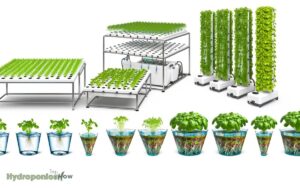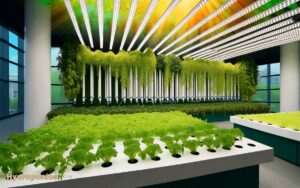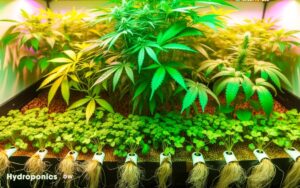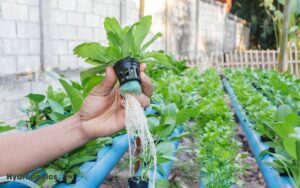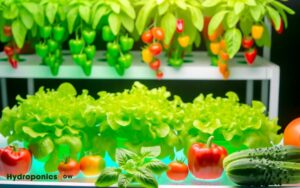Type of Plants You Can Grow in Vertical Hydroponics
Vertical hydroponic systems accommodate a variety of plants, such as leafy greens, herbs, strawberries, tomatoes, peppers, cucumbers, and edible flowers.
These setups maximize space and light exposure, essential for plant growth. Leafy greens like lettuce and spinach benefit from efficient nutrient delivery, while herbs such as basil thrive in controlled environments.
Strawberries, tomatoes, and peppers thrive due to ideal humidity and temperature regulation. Cucumbers and edible flowers can also be effectively cultivated, enjoying enhanced air circulation that reduces disease risks.
Each plant type has specific growth parameters, ensuring robust yields in vertical hydroponic systems. Explore further to optimize your system. Understanding the different types of vertical hydroponics can help maximize space efficiency and resource utilization. By selecting the right nutrient solutions and lighting conditions, growers can enhance plant health and productivity. Additionally, monitoring environmental factors like humidity and airflow ensures consistent growth and optimal yields.
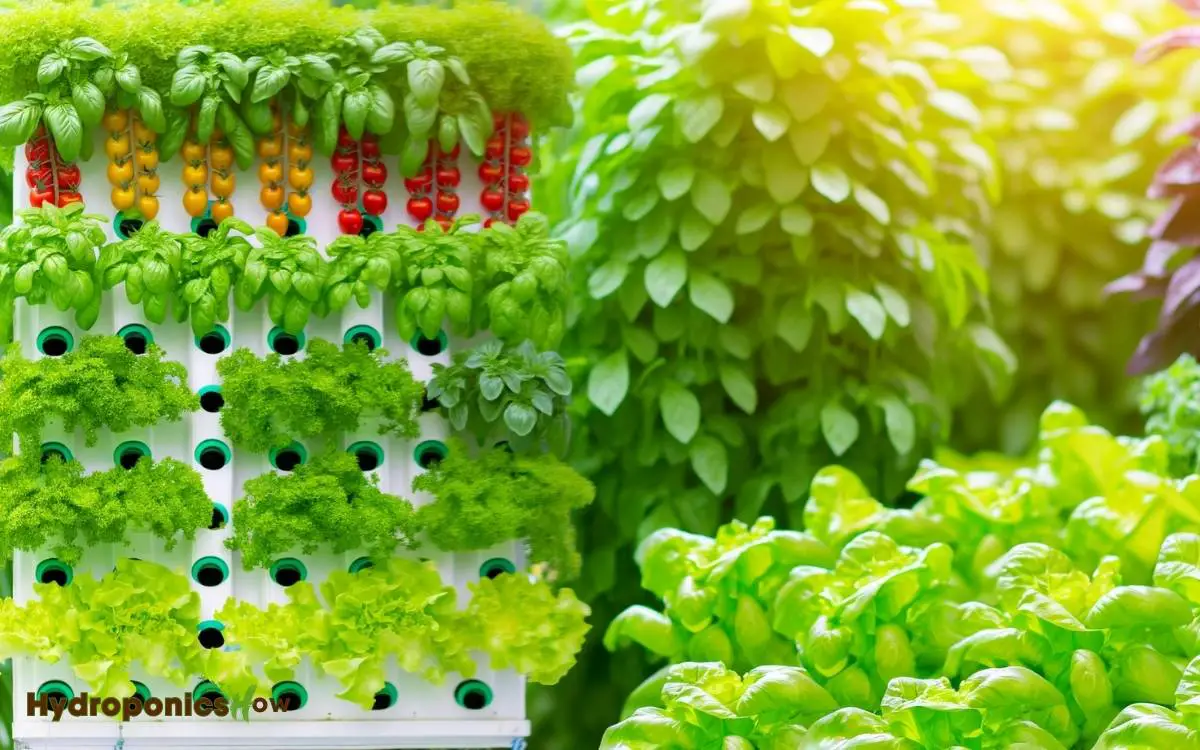
Key Takeaways
Leafy Greens
Leafy greens, including varieties such as lettuce, spinach, and kale, are particularly well-suited for vertical hydroponic systems due to their relatively short growth cycles and minimal space requirements.
These plants thrive in hydroponic environments where nutrient uptake can be precisely controlled. Lettuce, for instance, can mature in as little as 30 days, while spinach and kale follow closely with rapid growth rates.
The vertical arrangement allows for ideal light exposure and air circulation, critical factors in preventing common diseases like powdery mildew.
Additionally, the controlled environment of hydroponics minimizes pest infestations, enhancing yield quality.
Herbs
Herbs, such as basil, mint, and cilantro, are exceptionally well-suited for vertical hydroponic systems due to their compact growth habits and high demand for consistent nutrient delivery.
These herbs thrive in hydroponic environments where water and nutrients are precisely controlled, leading to robust growth and higher yields. Vertical setups maximize space efficiency, allowing multiple tiers of herbs to be cultivated simultaneously.
Below is a table summarizing key growth parameters for these herbs in vertical hydroponics:
| Herb | Ideal pH Level | Light Requirements |
|---|---|---|
| Basil | 5.5 – 6.5 | 14-16 hours/day |
| Mint | 6.0 – 7.0 | 12-14 hours/day |
| Cilantro | 6.5 – 7.5 | 10-12 hours/day |
These parameters promote optimal growth, flavor, and nutrient content.
Strawberries
Strawberries are an excellent choice for vertical hydroponic systems due to their adaptability to controlled environments and their high yield potential when grown under ideal conditions.
These systems provide strawberries with consistent nutrient delivery and ideal water supply, essential for maximizing fruit production.
Using techniques such as nutrient film technique (NFT) or aeroponics, strawberries benefit from enhanced oxygenation, promoting robust root development and overall plant health.
Additionally, vertical hydroponic systems enable efficient space utilization, allowing for higher plant density and increased yield per square meter.
Monitoring key parameters such as pH levels, typically between 5.5 and 6.5, and maintaining appropriate light exposure, around 12-16 hours daily, is essential for achieving peak productivity and high-quality fruit.
Tomatoes
Tomatoes thrive exceptionally well in vertical hydroponic systems due to their preference for well-aerated nutrient solutions and controlled environmental conditions.
Ideal growing conditions include maintaining a nutrient-rich solution with a pH range of 5.5 to 6.5, and providing 8 to 10 hours of direct light daily.
Common varieties suitable for hydroponic cultivation include Cherry, Roma, and Beefsteak tomatoes, each offering unique benefits regarding yield and flavor.
Ideal Growing Conditions
To optimize the growth of tomatoes in a vertical hydroponic system, maintaining a temperature range between 70-80°F during the day and 60-70°F at night is essential.
Adequate light intensity is critical, requiring 14-18 hours of high-quality light daily, preferably from full-spectrum LEDs.
Nutrient solutions should have a pH level of 5.5-6.5 and an Electrical Conductivity (EC) of 2.0-3.5 mS/cm. Ensuring consistent oxygenation of the nutrient solution is crucial for root health.
Humidity levels should be kept between 60-70% to prevent fungal diseases. Proper air circulation is also important to avoid pests and promote strong stem development.
Regular monitoring and adjustment of these parameters will contribute significantly to achieving the best tomato growth in a vertical hydroponic system.
Common Varieties
Selecting the right tomato varieties for vertical hydroponic systems involves taking into account factors such as growth habit, fruit size, and disease resistance, with some popular choices being cherry, Roma, and beefsteak tomatoes.
These varieties adapt well to the constraints and benefits of vertical farming.
Here are key factors to keep in mind:
- Growth Habit: Determinate (bush) varieties like Roma are compact, while indeterminate (vining) varieties like cherry tomatoes require more vertical support.
- Fruit Size: Smaller fruits like cherry tomatoes mature faster and are less likely to cause structural strain.
- Disease Resistance: Varieties bred for resistance to common pathogens thrive better in controlled environments.
- Yield: High-yielding varieties such as beefsteak tomatoes can maximize the output of vertical hydroponic setups.
These factors promote efficient production and plant health in vertical systems.
Peppers
Peppers are an excellent candidate for vertical hydroponic systems, particularly varieties such as bell peppers and chili peppers due to their compact growth habit.
Ideal growth requires a controlled environment with specific parameters: a pH level between 5.5 and 6.5, consistent nutrient-rich water supply, and adequate light exposure, preferably 14-16 hours of LED lighting daily.
Additionally, maintaining a temperature range of 70-80°F and ensuring good air circulation can greatly enhance yield and plant health.
Ideal Pepper Varieties
When selecting pepper varieties for vertical hydroponic systems, it is important to take into account factors such as plant size, growth habit, and fruit yield to guarantee excellent performance and space utilization.
Certain varieties are particularly well-suited for these systems:
- Bell Peppers: Compact growth and high yield make them ideal for vertical setups.
- Banana Peppers: Their slender profile and moderate height ensure efficient space usage.
- Jalapeño Peppers: Known for their manageable size and prolific fruiting, they are excellent for hydroponic environments.
- Sweet Mini Peppers: Small size and high productivity make them perfect for vertical farming.
These varieties not only maximize space but also ensure a consistent and rewarding harvest, ideal for both commercial and personal hydroponic applications.
Growth Requirements
Ensuring ideal growth conditions for peppers in vertical hydroponic systems involves meticulous control of key environmental factors. These factors include light intensity, nutrient composition, pH levels, and temperature.
Best light intensity ranges between 14 to 16 hours per day, with full-spectrum LED lights being preferable. Nutrient solutions must be rich in potassium, phosphorus, and calcium, essential for fruit development.
The pH level should be maintained between 5.5 and 6.5 to enhance nutrient uptake. Temperature control is critical, with daytime temperatures ideally between 70-80°F (21-27°C) and nighttime temperatures not falling below 60°F (15°C).
Consistent monitoring and adjustments are necessary to prevent nutrient imbalances, which can hinder growth and yield quality.
Cucumbers
Cucumbers thrive exceptionally well in vertical hydroponic systems due to their vining nature, which allows efficient use of vertical space and facilitates ideal light exposure.
This growth method offers several advantages:
- Key Space Efficiency: Vertical systems maximize limited space, enabling gardeners to cultivate a higher number of cucumber plants in smaller areas.
- Maximized Light Exposure: The vertical alignment ensures each plant receives consistent light, essential for peak photosynthesis and robust growth.
- Disease Prevention: Elevating plants reduces ground contact, minimizing the risk of soil-borne diseases and pests.
- Improved Air Circulation: The vertical arrangement promotes better air flow around the plants, which is essential for preventing fungal infections and ensuring healthy foliage.
This combination of benefits makes cucumbers an excellent candidate for vertical hydroponic cultivation.
Edible Flowers
Edible flowers are a versatile addition to vertical hydroponic systems, offering both aesthetic appeal and culinary uses in a variety of dishes. Common varieties include nasturtiums, pansies, and marigolds, each thriving in nutrient-rich, soilless environments.
Hydroponic setups provide ideal conditions for consistent growth, with controlled lighting, humidity, and pH levels.
This guarantees a robust yield of flowers that are not only visually striking but also high in nutritional value, containing essential vitamins and antioxidants.
The vertical design maximizes space efficiency, allowing for high-density planting. Incorporating edible flowers into vertical hydroponics can enhance the sensory experience of gourmet dishes, making them an excellent choice for urban gardeners and culinary professionals alike.
Conclusion
In summation, vertical hydroponics offers a versatile framework for cultivating a diverse array of plants, from the delicate leaves of leafy greens to the vibrant hues of edible flowers.
This method, reminiscent of the Hanging Gardens of Babylon, allows for efficient use of space and resources, thereby maximizing yield and sustainability.
By leveraging advanced techniques and technology, vertical hydroponics not only meets contemporary agricultural demands but also paves the way for future innovations in urban farming.

